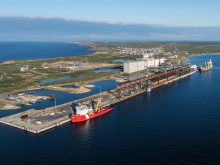Don’t ask more from farmers
Meetings are already being held to discuss strategy for the next round of world trade liberalization talks.
It seems early, considering the fallout from the last round is just starting to make itself felt strongly on the Prairies.
Agriculture ministers from the world’s leading economies met in France last week and made general pledges about further liberalizing world agriculture trade.
Figures released at the meeting show Canada has moved faster to hold up its end of the last deal than some of her trading partners.
Read Also

U.S. market can’t easily be replaced
The deputy chief economist of Farm Credit Canada says 92 per cent of Canada’s total exports to the U.S. went into the country duty-free in June.
That is pretty clear to western farmers, for whom grain transportation assistance and gross revenue insurance are only memories.
Prairie agriculture is scrambling to come to terms with the changes – investing in livestock production, broadening its mix of crops, building large grain handling facilities on main rail lines.
The increased cost of shipping grain to port has been a glaring entry for a couple of years in farm accounting books, but high commodity prices offset the cost. The bottom line for most farms was profitable.
Situation looks grim
But as spring approaches, price forecasts for 1998-99 are down for most agricultural commodities. Things could still turn around, but the wheat outlook is down about $5 a tonne, durum down about $7, feed barley down $10 and malting barley down $20.
New crop canola futures prices have fallen in response to the expected switch from cereals to oilseeds. The November contract on the Winnipeg Commodity Exchange March 6 closed at $369.20 a tonne while flax was $306 a tonne.
Average hog prices in 1998 are expected to be about $10 per hundredweight lower than the 10-year average. Cattle prices are expected to be up overall, but are struggling a bit so far.
Fuel and nitrogen costs are down a little from 1997, but overall, the profit picture for many producers will probably be gloomier than in the last couple of years.
If they get into trouble, all they have to fall back on is the Net Income Stabilization Account. And many observers wonder if NISA will be up to the task, especially in the case of young farmers who haven’t had much chance to make deposits for a rainy day.
Prairie farmers are tightening their belts. They’ve paid their dues to be members of the trade liberalization club. They shouldn’t be asked to do more, at least not until the rest of the world catches up.














